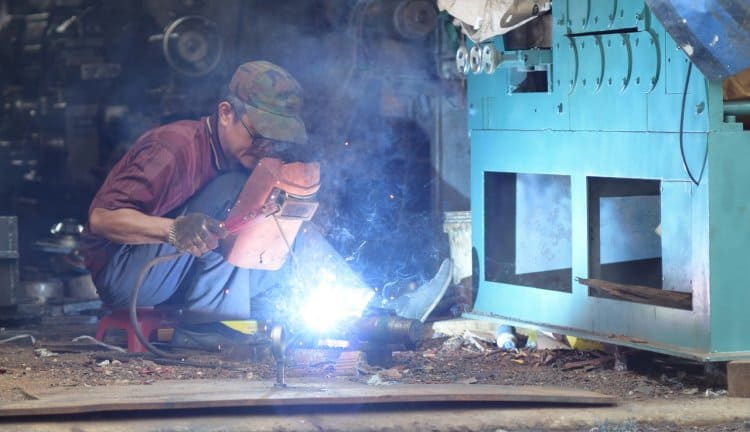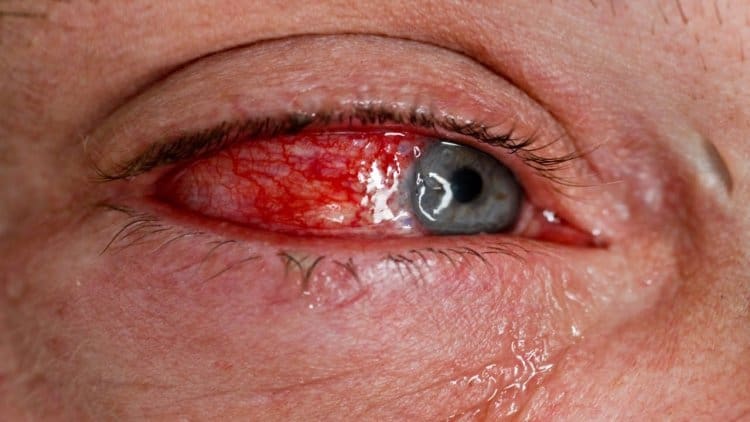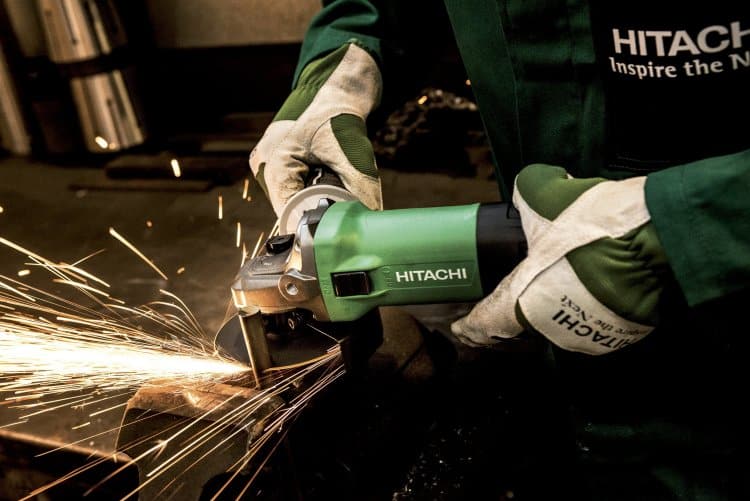This post contains affiliate links to products, services, or education. We may receive a commission for purchases made through links.
If you’re considering starting a career in welding, it is necessary to go into it fully knowledgeable as to the hazards involved. There are many ways that a welder can be injured on the job, and one of the most talked-about is damage to the eyes.
So, can welding damage your eyes? If proper safety measures are not taken, welding can damage your eyes either from UV radiation damage or from debris flying into the eye. While UV radiation is serious and more talked about, injuries caused by debris are more common, and potentially more severe. All eye damaged caused by welding is preventable.

According to Industrial Safety and Hygiene News, there were nearly 2,000 injuries to welder’s eyes that required them to take at least a day away from work in 2014. These eye injuries account for over one-third of the total injuries that year.
Learning the hazards that welding poses for your eyes and how to prevent damage to them is vital for the safety of any welder. In this article, we discuss the types of injuries you can expect as well as how to prevent them.
Welding UV Radiation Damage
What is welding UV radiation damage?
The UV radiation that welders experience is commonly known as welder’s flash, flash burn, or arc eye and clinically known as photokeratitis. It is essentially a sunburn of the eye.
Outside of welding, the same damage can be sustained from intense exposure to sunlight.
The UV radiation produced when welding is either absorbed or passes through the cornea. While it absorbs or passes through, it can cause damage to the cornea the same way UV radiation in sunshine interacting with our skin causes a sunburn.
UV radiation is not only a problem for the person doing the welding.
Bystanders or other welders not using the right safety equipment can be exposed to UV radiation without knowing it.
Much of this UV radiation is invisible to the naked eye, so you don’t necessarily know when you’re looking at it, and it doesn’t just stay near the welder.
Symptoms of UV Radiation Damage in Welders

You probably already know what it feels like to have a sunburn on your skin. If you imagine that to your eye, you’ll quickly understand that a flash burn is no laughing matter.
Here are the symptoms of UV radiation damage to your eye:
- Pain, depending on the severity it can range from mild to severe
- Bloodshot, teary eyes
- Itchy eyes or feeling like something is in them
- Sensitivity to light
- Trouble seeing clearly or blurred vision
If you have UV radiation damage from welding, you’ll know it.
What Should You Do If You have UV Radiation Damage
It is always a smart idea to see a doctor if you have UV radiation damage. A doctor can guide you on how soon you can return to work, determine the extent of the damage, and offer helpful therapies for making a speedy recovery.
Additionally, any time you sustain an injury on the job, it is a good idea to have it documented by a medical professional.
How Quickly Can UV Radiation Damage Happen When Welding?
There is no hard and fast rule for how long you can be exposed to the intense UV radiation before your eyes incur damage.
Whether you experience a flash burn depends on:
- How intense the UV radiation is
- The angle that the UV radiation meets the eye
- Your distance from the arc
- What, if any, eye protection is being used
A second or two exposure to intense UV radiation can cause a flash burn in the right conditions. Still, in best-case scenarios, you could go all day without experiencing any issues.
Is UV Radiation Damage Permanent?
The good news is that it is infrequent for anyone to experience lasting damage to their eyes from UV radiation exposure.
Repeated and long term exposure to UV radiation can cause cataracts, and it certainly isn’t good for your eyes to have to heal after exposure repeatedly.
This is where your preventative measures come in.
There are many people out there welding all day without experiencing adverse effects on their eyes.
But UV radiation damage isn’t the only thing you have to worry about.
Welding Debris Eye Damage
Unlike UV radiation damage, the injuries caused by debris flying into the eye can very well be permanent, depending on the severity of the injury.
So, it is just as essential to protect your eyes while you’re doing non-welding work as it is when you’re in front of the arc.
Here are some examples of work that can cause debris to fly into your eye:

- Using a grinder: Any grinder being used for just about any job can cause fine particles or even large pieces to fly up and into your face.
- Chipping or hammer slag: Obviously, pieces can fly when you’re doing this. Whether they meet your eye or not is just luck, which is why protective equipment is required.
- Cutting: Cutting with either with a plasma cutter or saw produces particles that can fly at your face.
- Welding: While welding, sparks, flames, and splatter may hit your face or your eyes.
The human eye is pretty good at healing itself, especially with a little help from a medical professional. It isn’t a reason not to weld, but it is an excellent reason to take the appropriate steps to protect yourself.
Protecting Your Eyes While Welding
Protecting your eyes while welding is not tricky. All it takes is a little forethought and an understanding of the dangers.
And before you ask, no, you should not use sunglasses for welding…
What You Need to Protect Your Eyes While Welding
To protect your eyes from UV radiation and flying debris, you need:
- A welding helmet: The welding helmet should be of the best quality, fit properly, and have darkening filters (either passive or auto-darkening is fine). Check out our recommended welding helmets here.
- Side protection: Some helmets have removable side protection, while others have permanent. Either is fine for use, but if your side protection is removable, never forget to put it back on while welding. This is especially important when you’re working alongside other people.
- Shade selection chart: This chart helps you select the right filter for the work you’re doing.
- Protective glasses: You should wear protective eyeglasses under your welding helmet.
As long as you are wearing the proper protective gear and it fits as it should, your eyes shouldn’t need to worry too much about your eyes!
What You Can Do to Protect Your Eyes While Welding
Now that you know what you need, there are still some simple things you can do to be sure that you don’t suffer any eye damage while on the job. Here are our tips:
- Stay informed about OSHA regulations. These regulations are vital for you to know and should always be followed. Stay apprised of any changes to regulations that concern welders to stay safe on the job.
- Be aware of your coworkers. You don’t have to have the welding stick in your hand to get an eye injury. If someone around you is welding, it is best to stay at least 50 feet away or to wear your welding helmet and safety glasses.
- Upgrade your safety equipment. When it comes to protecting your eyes, you want only the best. If your welding helmet has seen better days, it might be time for an upgrade.
- Have your eyes checked. Make an appointment with your eye doctor to make sure you don’t need glasses and to be sure that you don’t have any permanent issues with your eyes due to welding.
- Make sure you have ventilation. Fumes and gas can irritate your eyes (and are hazardous for several other reasons). To protect your eyes, make sure the work area is ventilated.
Welding Can Damage Your Eyes
Although welding can damage your eyes, most of the time, the damage is not permanent, and it is preventable all of the time through the use of safety equipment.
Wearing a welding helmet might be uncomfortable or sometimes too dark, but take our word for it – it is better than having molten metal fly into your eye.
